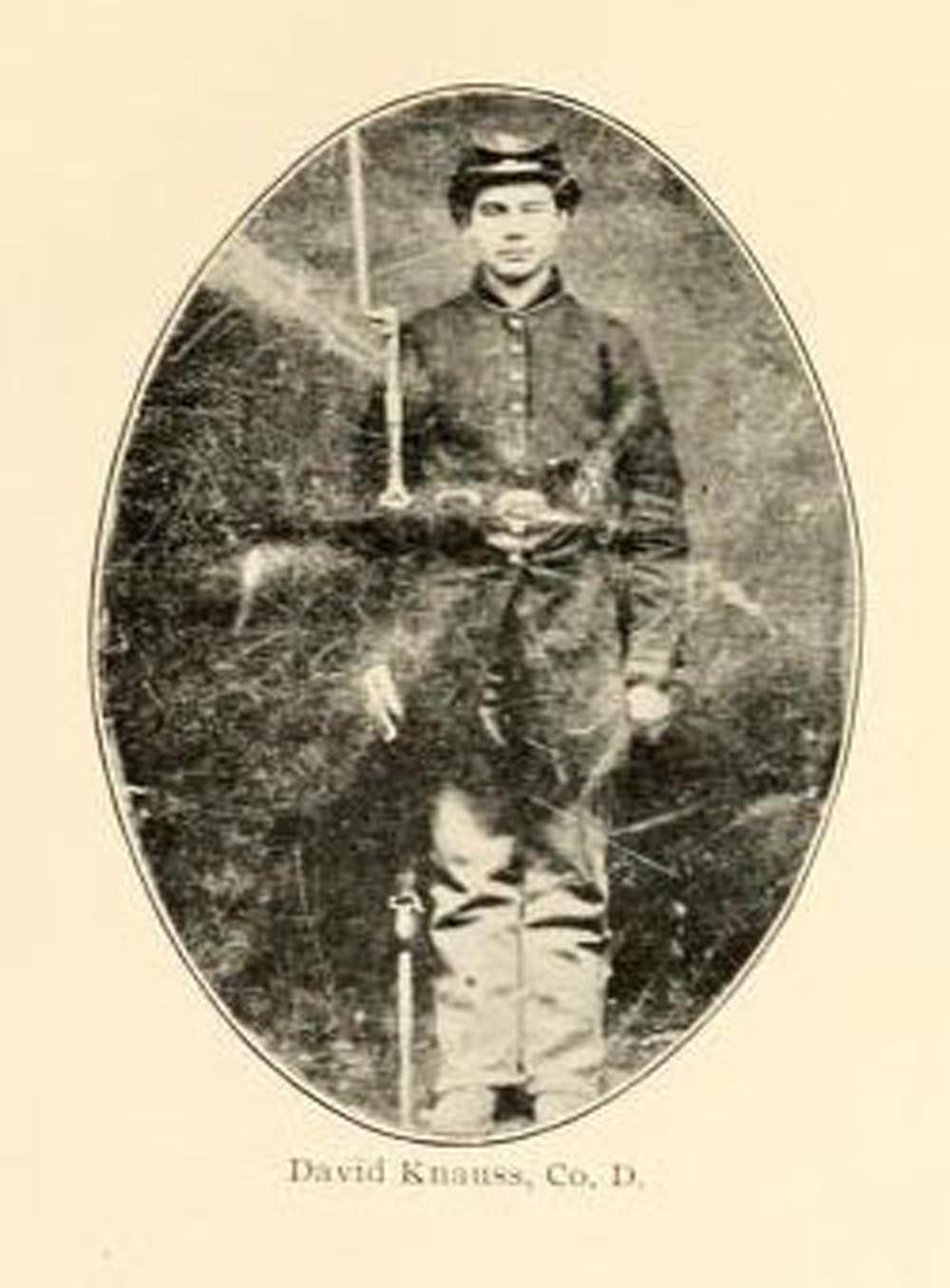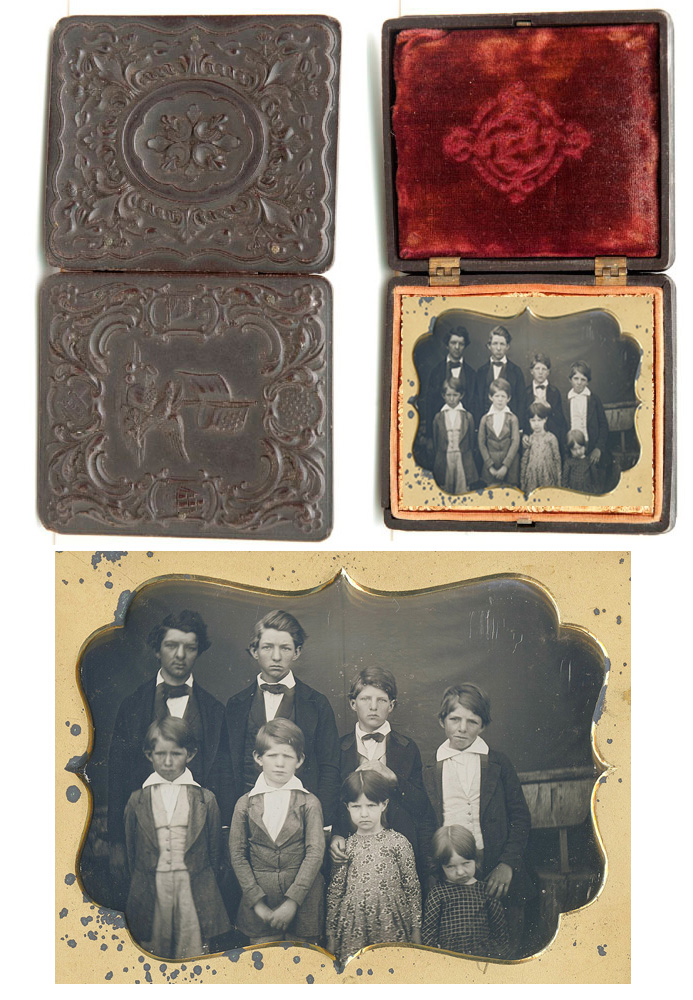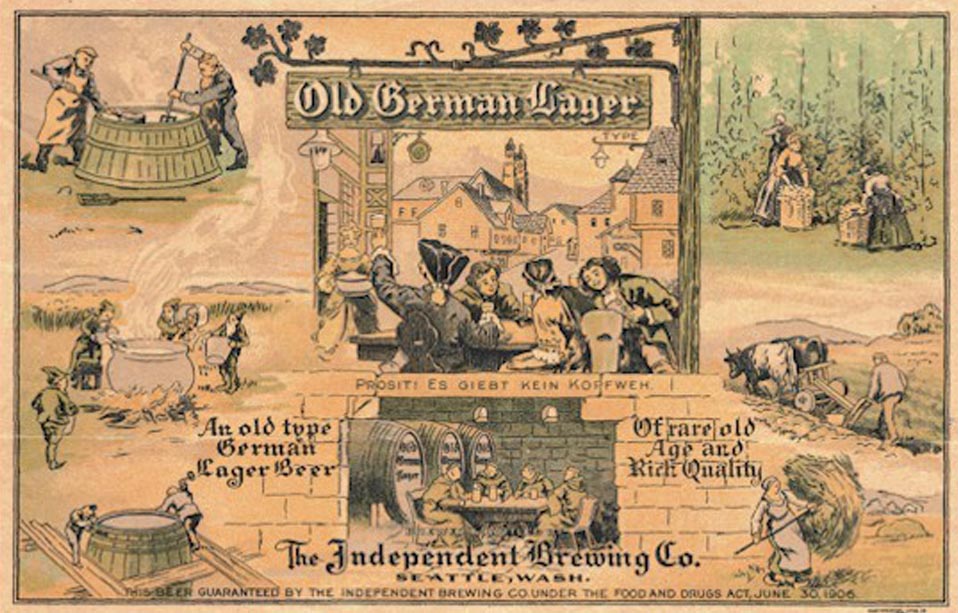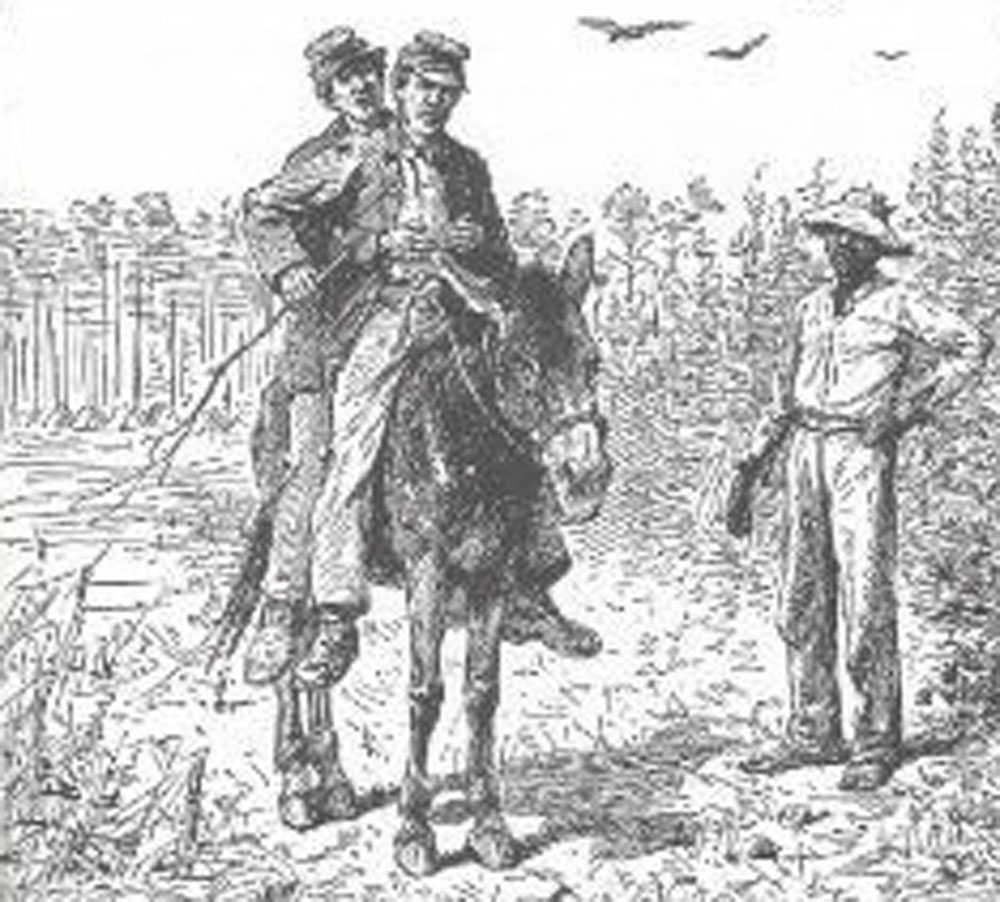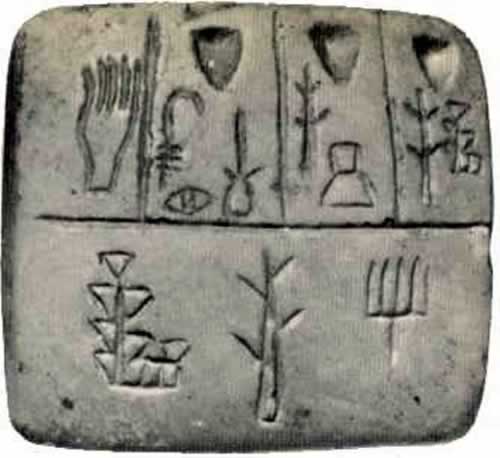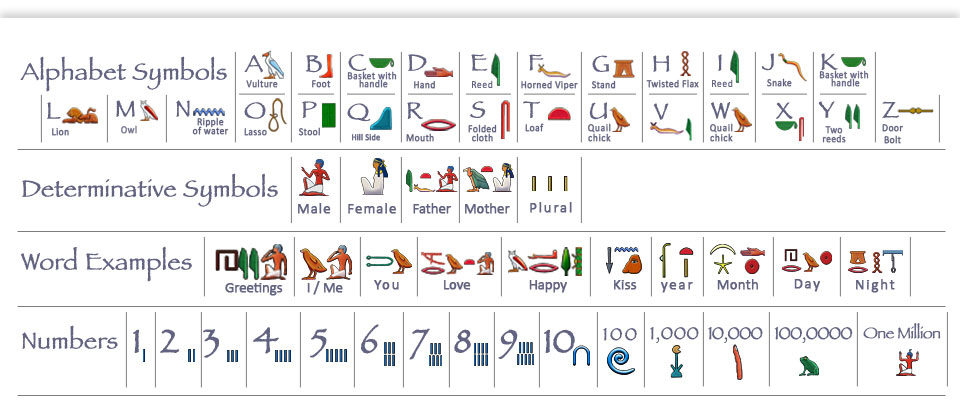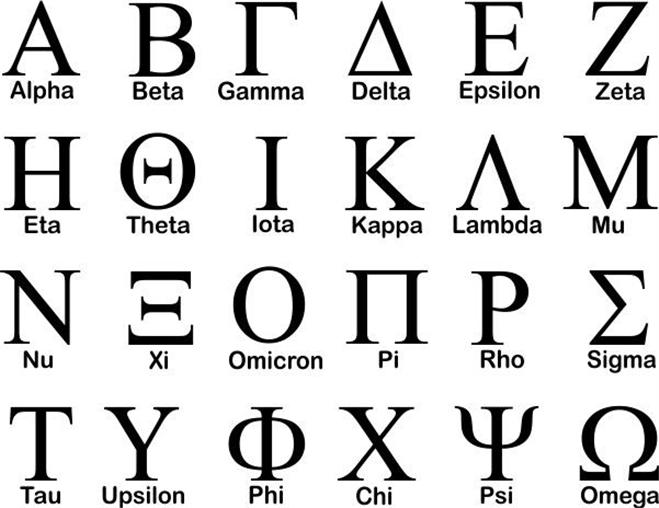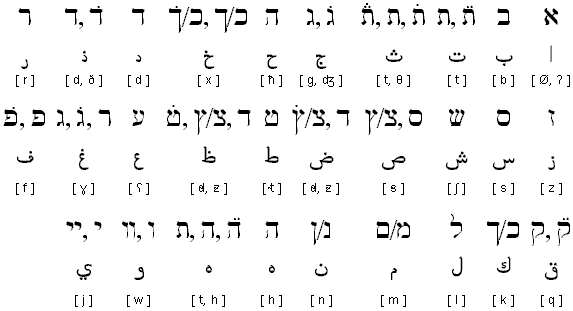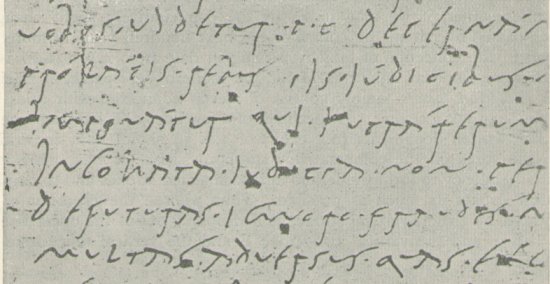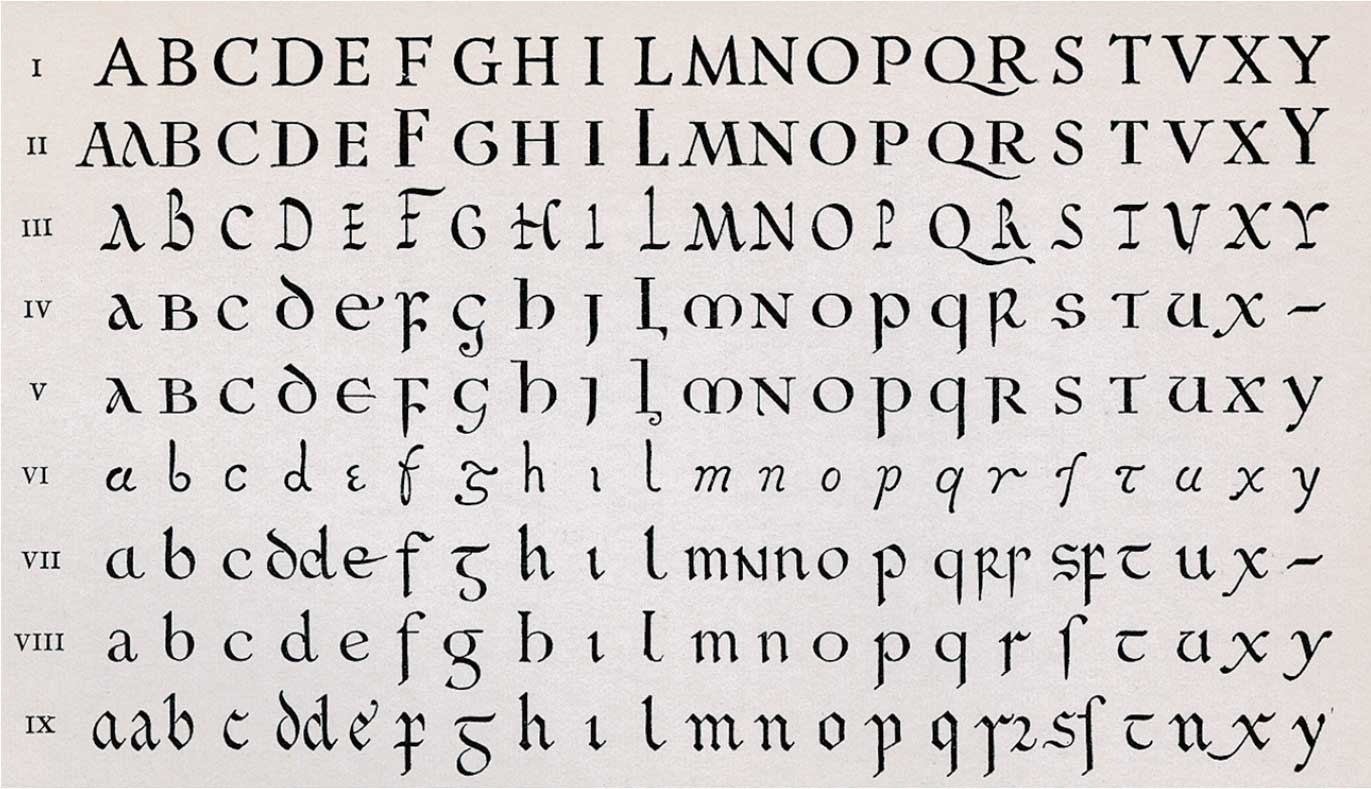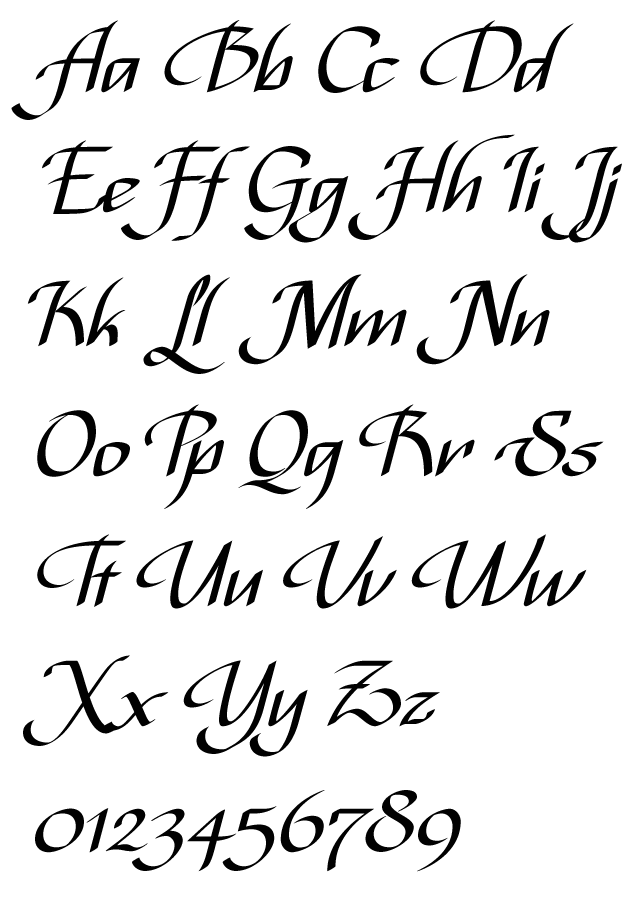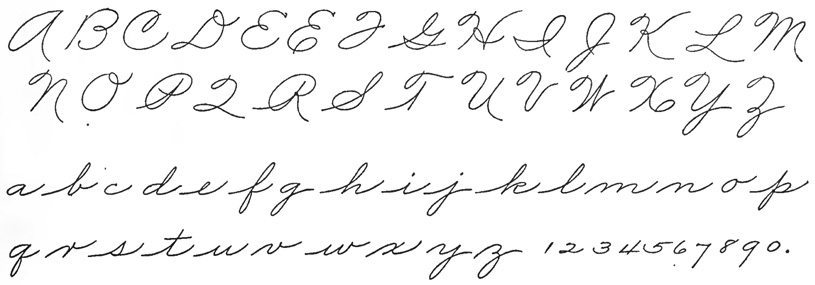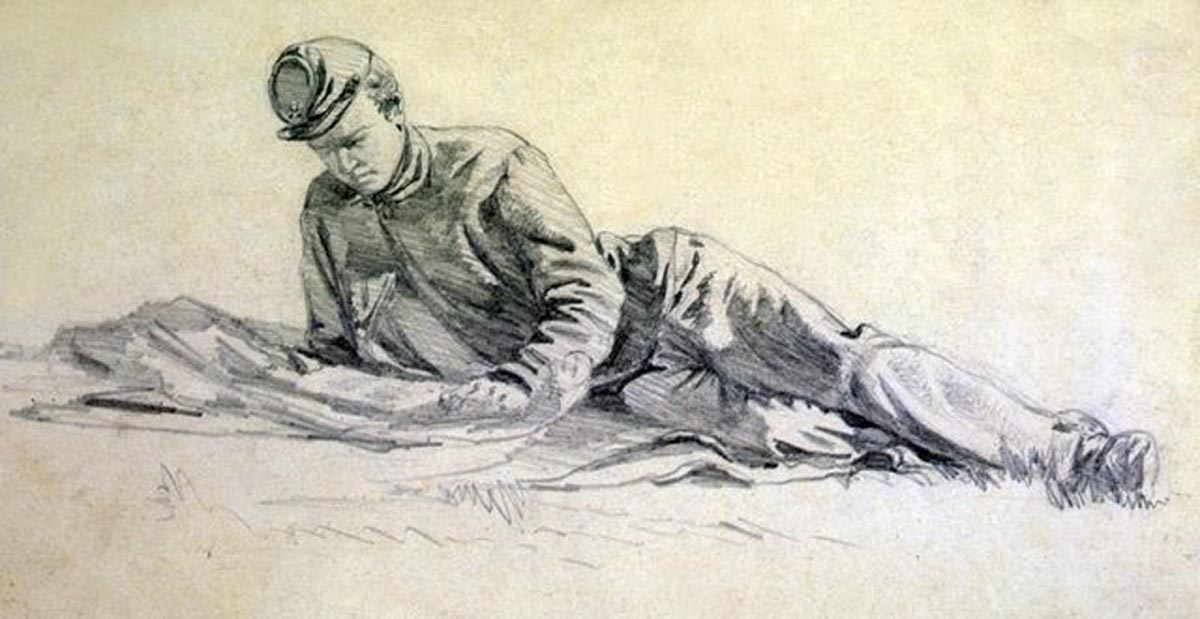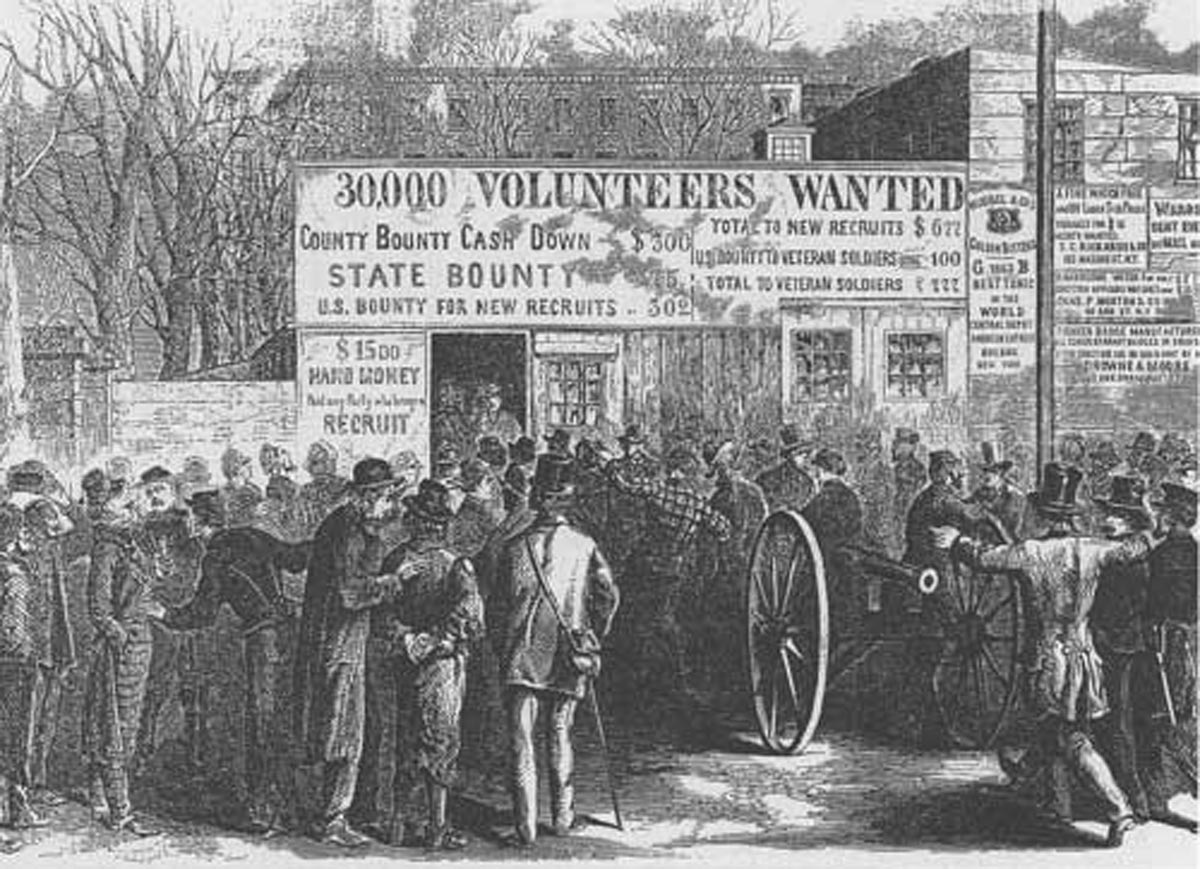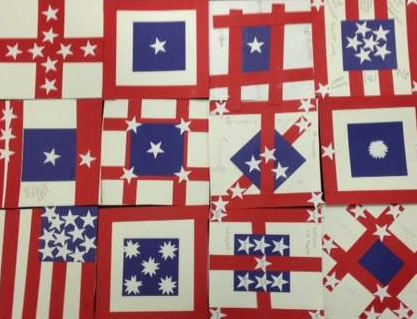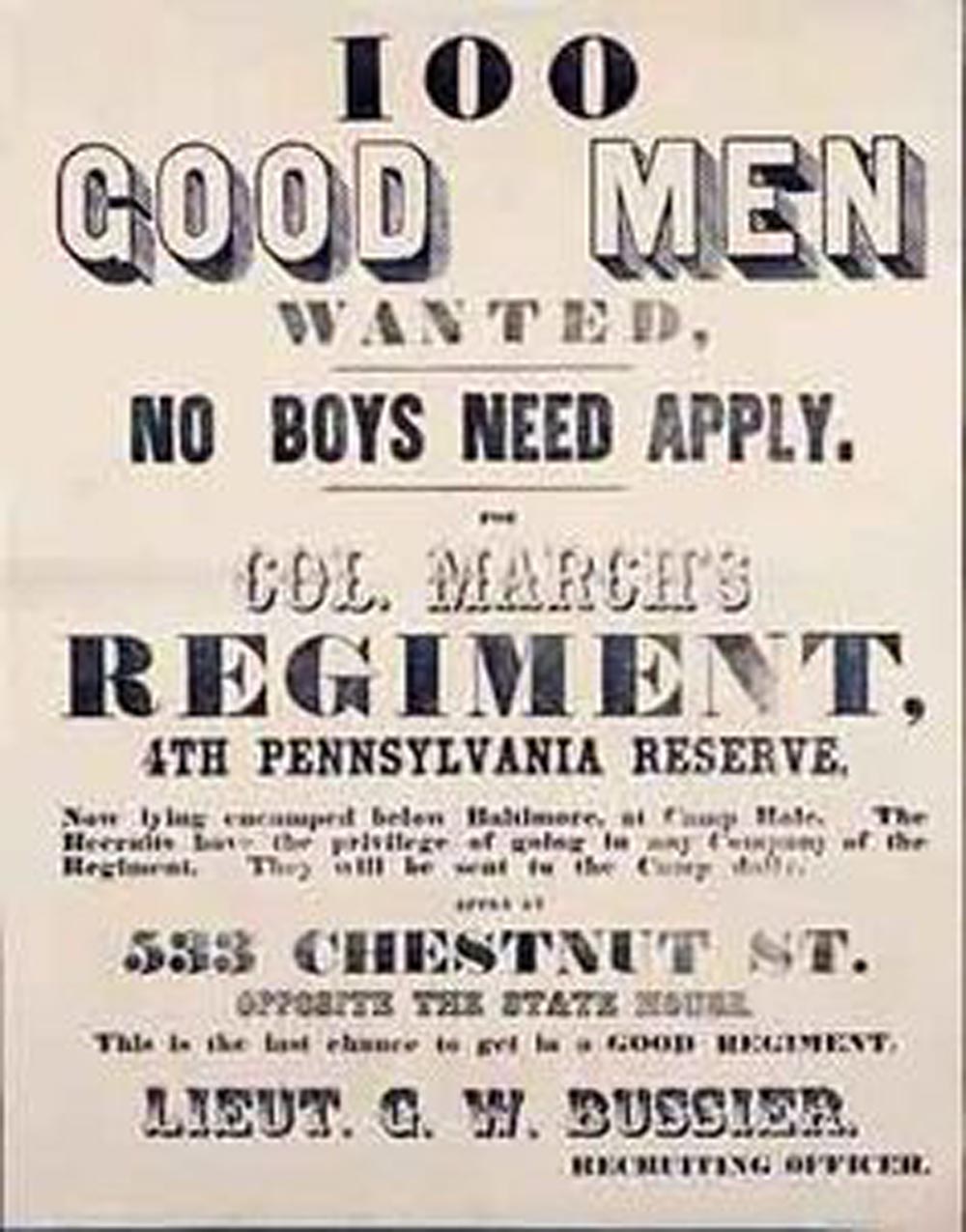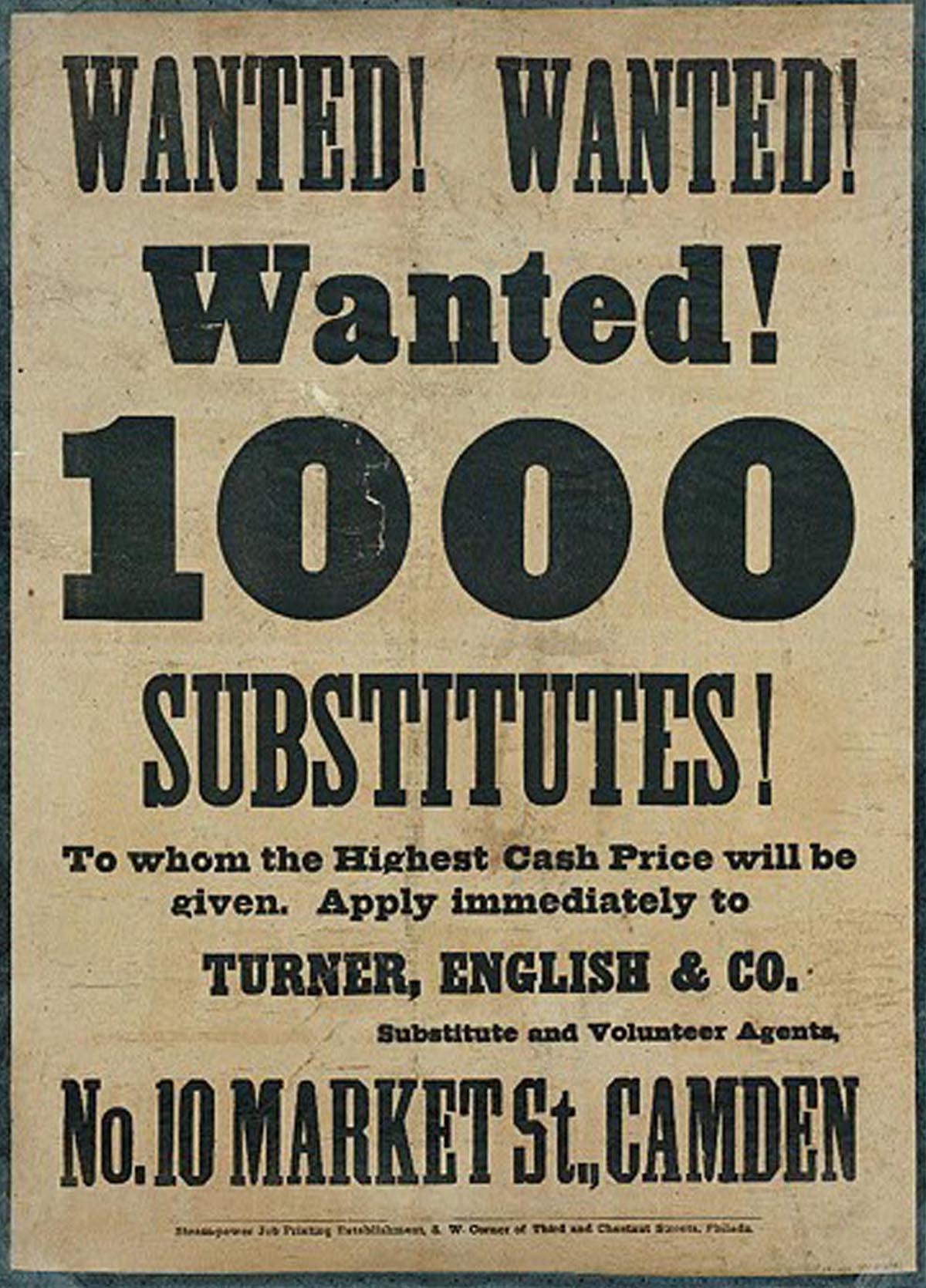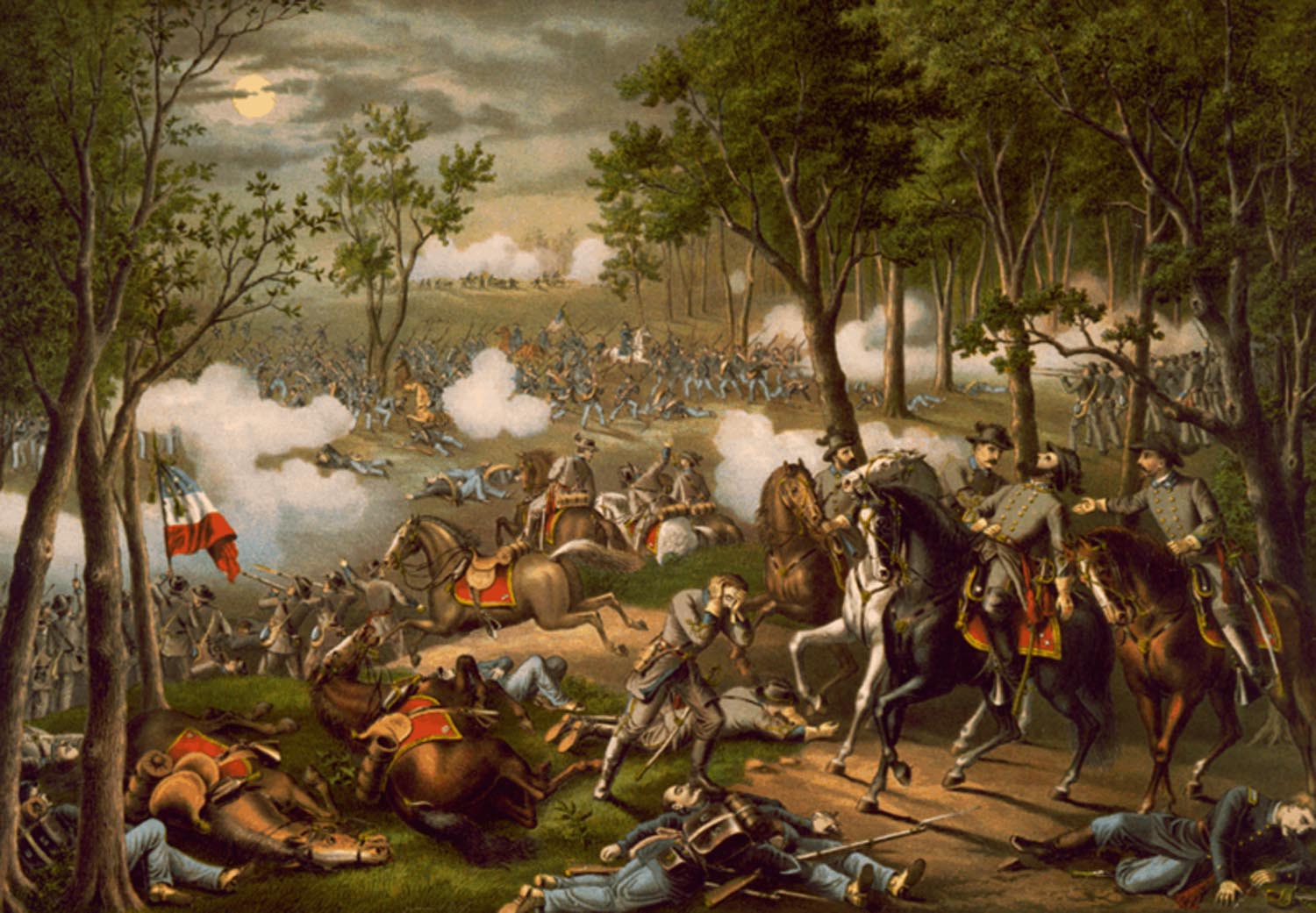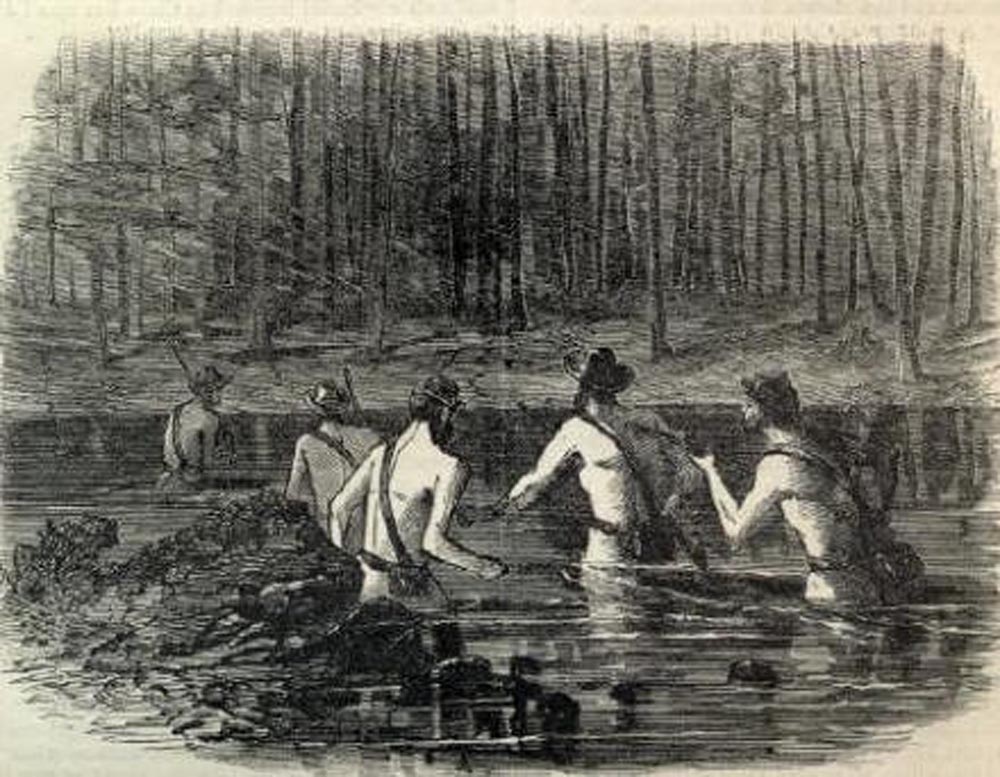David Knauss, Co. D, 153rd Pennsylvania Volunteers
Soon after David Knauss was born his father moved the family to Northampton County Pennsylvania where he spent his boyhood days on the family farm. Farm land was being sold in 80 acres plots and it was good bottom land. His father and a neighbor Jonah Godfreed bought one plot together and broke it up into two farms. David grew up with Jonah’s only son. He was a very large baby when he was born and his father gave him the name Chunky.
best friends
From the time this boy was in grade school no one messed with him or his best friend. David was small in stature, but he often stated, “I’m tall. It is just that everyone else is taller”. When the two boys wrestled and if David had fought real hard, sometimes Chunky would let him win but not always. But when it came to running no one could keep up with David. Chunky told him one day, “ the reason you can run so fast is your legs are shorter and you are closer to the ground”.
Together the boys made fond childhood memories of playing in the barn hiding in the hay. They used to make forts in the big piles of animal feed. Together they had found the best trout fishing holes in the stream that separated their two properties. The entire 80 acres was well known to them like each other’s face. The wild game was plentiful, and the fishing was always good. They gathered mushrooms in the spring, as well as acorns for making Chicory in the fall and traded them in town. In times of coffee shortage or economic crisis like the Civil War, Chicory root or Acorns were ground up and added to stretch out the supply. Parsnips were also added occasionally. Even burnt sugar was sold to coffee dealers and coffee-house keepers under the name of “black jack”.
chicory coffee
Although the two boys were the same age, Chunky was 1 month older than David, and they argued about that all the time. They received their education in the Township Schools, and in the woods of Northampton County. Running through the thickets and tall trees the boys became closer to God’s creation. They learned about Him on Sunday and the rest of the week felt His presence under the trees. They learned how to hunt and fish and survive in the forest. These two young men could provide for their family at an early age and they often did so. It was no surprise to anyone when later as young men they enlisted together.
David’s uncle owned the entire 80 acres next to his father’s farm. So, David and Chunky spent a lot of time playing with his cousins. The families very were large. Parents and several children, as well as an aunt, uncle, or a grandparent or two, lived under one roof. The close nit family ties gave all the young people in the neighborhood a sure sense of security. The families always got together for each holiday and shared the meal. The adults at the adult table, and the kids got their own table in another room. One year, when they were outside celebrating the fourth of July with a big barbecue, a traveling photographer stopped in on his way to town. He got all the children together and took a picture and for 25 cents each child got a small tintype. A tintype was made by creating a direct positive on a thin sheet of metal coated with a dark lacquer or enamel and used as the support for the photographic emulsion. Tintypes enjoyed their widest use during the 1860s and 1870s.
how to make a tintype
Tintype portraits were at first usually made in a formal photographic studio, but later they were most commonly made by photographers working in booths or the open air at fairs and carnivals, as well photographers traveling with their studio set up in a wagon.
the traveling photography studio
The process was first described by Adolphe-Alexandre Martin in France in 1853. In 1856 it was patented by Hamilton Smith in the United States and by William Kloen in the United Kingdom. It was first called melainotype, then ferrotype by a rival manufacturer of the iron plates used, then finally tintype.
a tintype was more durable than a paper photograph
One or more hardy, lightweight, thin tintypes could be carried conveniently in a jacket pocket. They became very popular in the United States during the American Civil War. Although prints on paper soon displaced them as the most common type of photograph, the tintype process continued to enjoy considerable use throughout the 19th century and beyond, especially for casual portraiture by novelty and traveling street photographers.
This was a rural farming community and all the children in that neighborhood went to the same one room school house. David and Chunky had many friends from families of different backgrounds. The Indian children from the Delaware tribe that went to the school were younger than David, but the boys taught them many things about surviving alone in the woods. The older boys loved to listen to the younger ones tell stories about their family’s life experiences as Native Americans.
Delaware Native American Indians
The Delaware Indians were originally known as the Lenape or Lenni Lenape Indians, the name they called themselves. The American colonists named them the Delaware Indians because their original homelands were along that river. These young braves were from different clans called Pele, the turkey, Tukwis-t, the wolf, and Pukuwanku, the turtle. They all had one thing up on David and the other kids. They could speak in more than one tribal language and pretty good English to boot. They were held in great favor among the other students in school. Later these clans will be removed to Oklahoma.
Delaware Indians signing the Treaty of Penn with Benjamin West
The Treaty of Shackamaxon, otherwise known as William Penn’s Treaty with the Indians or “Great Treaty,” is Pennsylvania’s most longstanding historical tradition. According to the tradition, soon after William Penn (1644-1718) arrived in Pennsylvania in late October 1682, he met with Lenni Lenape Indians in the riverside town of Shackamaxon (present-day Fishtown). There, beneath a majestic elm, they exchanged promises of perpetual friendship.
the Penn belt of wampum
In 1857, Granville John Penn donated to the Historical Society of Pennsylvania a belt of wampum (shell beads) depicting two men joining hands; the Lenapes had purportedly presented it to his great grandfather at the Treaty.
swing time
All the children played together outside except when the boys wanted to play war. Then the girls found better things more interesting to them to play with. They would play house with their doll and pretend to be a mother, or have a tea party. Girls liked to read books and notes from each other. At church the girls gathered in a circle and usually were left un-attended. The teachers spent more time with the boys because the girls were better behaved. They love to gossip about the boys when they got into trouble and, “old so and so said”, stuff. Girls love to have sleepovers whenever they could. Girls spent a great deal of time whispering and giggling, and passing notes.
girls playing together
There were two girls that stood out among the other young ladies that attended the local school and church. Rachel and Ruth were twin sisters that made you see double. They looked so much alike that they often traded names, so they could confuse any person trying to talk to them. Once when they were just newborns getting their first bath, their mother suddenly realized that she did not know which one was which. There was a small freckle in the eyebrow of one of the babies, so she decided, “this one shall be Rachel, because I will never tell that I got them mixed up”. Their mother never told the girls how she could tell them apart, but she could, and they always wondered how. As they grew older it was easy to tell them apart. Rachel was always the perfect little lady all prim and proper. Ruth sometimes enjoyed playing with the boys and she grew up to be a quite a tom-boy. But, when the two girls wanted to, they could keep you guessing who was who.
Whenever the girls wanted to play together without the boys in the way they would say, “let’s ask Rachel and Ruth what they want to do now”. Young girls in those days, in some areas rarely attended school, homemaking was a full-time job. What they would mostly do during their pass time is sewed, do needlework and visited one another. Women and girls would spend much of their time writing letters. Because paper was difficult to obtain at the time, the girls wrote on birch tree bark, in the sand, and on the ice and snow. They used the leaves of the trees and scrap strips of leather for their manuscripts.
In Northampton County, all the children went to school together, boys and girls. Classes would be held sometimes, due to the season, either inside or out. Each child had a small black chalk board to, work out, and complete the lessons. Good penmanship was always a requirement. All the girls loved to practice their hand writing and they felt lucky when they got a piece of paper to do it on.
Platt Rogers Spencer penmanship chart
Platt Rogers Spencer designed the Spencerian method of cursive handwriting. He is known as the “Father of American Penmanship”. His writing system was first published in 1848, in his book Spencer and Rice’s System of Business and Ladies’ Penmanship.
girls at play
The boys thought that playing war was fun. You could shoot at anything with just using your forefinger of either hand. Your guns never ran out of ammunition or bullets. And if you made a good, “bang” sound it was quite a believable hand toy. But the best part of playing war, was playing dead. You were judged by the other boys on how well of an actor you were. An even better part of the game was you could get up after being killed, and keep on playing war again, and again with the same results. Nobody really died. It was just a fun game.
Although, sometimes things got a little ruff out there in the brush. One time one of David’s cousins was using a stick as a rifle, and as he was running the stick became lodged between two trees and broke. The broken piece struck the boy on the right side of his face. It gave him quit a cut that later left a small but deep scar. This young lad did not complain he brushed it off by saying, “I drew first blood” and along with the other boys they all had a great laugh.
Whenever the boys wanted to play war, which seemed like always, the girl had no problem keeping busy doing girl things. When they had time away from learning about homemaking, girls played games. The game of Graces was played by two players, either two girls or a girl and a boy. Boys did not play Graces with one another because it was considered a “girl’s game.” The game involved whirling a colored hoop toward your partner, who attempted to catch the hoop on the tip of a slender wand. This elegant game was considered to offer young ladies both proper and correct exercise.
graces
One game the girls did play with the boys was Jackstraws or Pick-up-sticks. The Indian children at the school taught them to play it with straws of wheat. To play, all that was needed was a pile of wood splinters or straws. The sticks are heaped in the middle of a table. Each player takes a turn removing one stick from the pile. The challenge is to do so without moving any of the other sticks.
jackstraws
Playing dominoes was a favorite pastime in the late 1800s. This game was played by young and old. Dominoes are flat, rectangular blocks called tiles or bones. Each tile has two groups of dots on one side. The dots range in number from zero to six. The tiles are put in the middle of the table, face down. The first player to lay down all of his or her dominoes by matching up the numbers wins.
Civil war dominoes
Rachel and Ruth were inseparable when they were young but as they grew older Ruth got into more outdoor things like the boys were into. She loved to go hunting, not so much for the thrill of the kill, but she liked the “free-ness” of being out in the woods. She had no problem slipping on boys pants to keep warm when she went hunting with them during the winter months. She was a deadly shot with her father’s rifle and she bagged her first big buck when she just turned a teenager at the age of 13. The boys with her that day were amazed that Ruth insisted that she field dress out her own deer. Thereafter, Ruth always had a well-deserved, and very proud memory of that day.
first deer
Rachel loved to read, and she devoured anything in print. She used to keep all the newspapers she could get her hands on, so she could read the stories again and again. She cut out the stories that sparked here interests’ and kept them tucked neatly between the pages of a book. She loved to read the letters they published by Florence Nightingale about her experiences as a nurse in the Crimean War from 1854 to 1856. Nightingale was a prodigious and versatile writer. Her published work was concerned with spreading medical knowledge. She wrote her tracts in simple English so that they could easily be understood by those with poor literary skills.
letter from Florence Nightingale to Lord Raglan, 8 January 1855
Florence Nightingale, at the age of 24, and coming from a wealthy Italian family, felt called by God to help the poor and sick. She is considered the founder of modern nursing. She was known as, “the lady with the lamp”, when her and her nurses went to the Crimean War, and they saved many lives.
Miss Nightingale in the hospital in Scutari, 1856
Rachel read about her, as a nurse she took notice of the dirtiness and deterioration of the military hospitals. The conditions in the hospitals were very bad. Hundreds of soldiers were injured in the fighting. In those days, hospitals were basic, and the soldiers were not even given food and medicine to help them get better.
Florence Nightingale
Florence Nightingale told in her letters how when she got to the hospital, she saw that wounded men were sleeping in overcrowded, dirty rooms without any blankets. Wounded soldiers often arrived with diseases like typhus, cholera and dysentery. She saw that more men died from these diseases than from their injuries.
Nightingale used this statistical data to create her
Polar Area Diagram, or “coxcombs” as she called them.
Rachel could tell from reading her letters that the army doctors who worked there did not want the nurses helping. But, soon after they arrived, however, there was a very large battle and the doctors realized they needed the nurses’ help. Florence Nightingale realized that if the doctors were going to allow her nurses to work then they had to do a very good job.
the lady with a lamp
Rachel fully embraced the Nightingale effect which was a situation where a caregiver develops a romantic feeling for their patient, even if very little communication or contact takes place outside of basic care. She believed that feelings will fade once the patient is no longer in need of care. The two sisters enjoyed a lifetime close relationship. Whenever they were apart they always communicated daily with a short letter.
Jonah Godfreed, Chunky’s father ran a brewery on his farm. He grew grain, hops and all the things he needed to make beer that the local German people drank. David worked with Chunky at the brewery and at one time they talked about starting out on their own making beer. Beer is one of the oldest beverages humans have produced. The invention of bread and beer has been argued to be responsible for humanity’s ability to develop technology and build civilization.
old style German beer
Previously beer had been brewed at home, but the production was now successfully replaced by medium-sized operations of about eight to ten people like Jonah Godfreed. Beer, one of the most common drinks, was consumed daily by all social classes where grape cultivation was difficult or impossible. Though wine of varying qualities was the most common drink in the south, beer was still popular in the north. Beer became vital to all the grain-growing community. Jonah Godfreed’s beer was brewed the old German family way which he kept a secret to himself.
At the outbreak of the Civil War, like all young men at that time, David’s first thought was duty to his country. Even though his father and mother did not approve, he entered the service. It was in the Autumn of 1862 when the war trumpet was sounded throughout the North calling for recruits to strengthen the Union forces. Robert E. Lee’s army threatened a northern invasion and more men were called upon to repulse the enemy. Northampton County in lieu of a draft, raised a full regiment of volunteers.
“Henry, home”
David and Chunky rode together on the same mule named Henry on the way to enlist. When they got there all they had to do was turn him loose and swat him on the butt, then shout, ‘Henry, home” and the mule would find his own way back to the barn. David and Chunky enlisted together in Company D.
a company of Pennsylvania Infantry
David was an avid reader and he would devour any books he could get his hands on. His penmanship was impeccable and he also mastered numbers. The earliest known example of writing is the Sumerian pictographic system found on clay tablets, which developed around 3200 BC into a modified version called cuneiform. Cuneiform is from the Latin word meaning “wedge-shaped” and was impressed on wet clay with a sharpened reed.
Sumerian pictographic tablet 3100 BCE clay tablet
The Egyptian system of hieroglyphics also begin about this time using a system of syllabic writing. Two cursive scripts were created shortly after hieroglyphs were invented. Scribes wrote these scripts on papyrus, with ink using a reed pen.
the hieroglyphic typewriter
The Phoenicians developed a vowel-less system of 22 letters around the eleventh century BC. This is the first know alphabetical system of writing.
Phoenician alphabet
The Greeks adapted the Phoenician alphabet around the eighth century BC. They added vowels, dropped some consonants, and changed the order. They used all capital letters. Classical Greek lowercase letters were not invented until the Middle Ages.
ancient Greek alphabet
The Phoenician alphabet also influenced the Hebrew and Aramaic scripts, which follow a vowel-less system. One Hebrew script was only used for religious literature. Square Hebrew script, used in Israel, was developed from Aramaic around the third century AD.
Judeo-Aribic script
The Romans in Southern Italy eventually adopted the Greek alphabet as modified by the Etruscans to develop Latin writing. Like the Greeks, the Romans employed stone, metal, clay, and papyrus as writing surfaces.
traditional Roman
Roman cursive or informal handwriting started out as a derivative of the capital letters, though the tendency to write quickly and efficiently made the letters less precise.
cursive handwriting from the reign of Claudius (41 to 54 AD)
By the fifth century A.D. it included early versions of lowercase letters and sometimes flowed like modern cursive. Late in the eighth century Charlemagne tasked an English monk with standardizing the system. Influenced by Roman characters, Carolingian miniscule was designed for maximum legibility and featured lowercase letters, word separation and punctuation.
Carolingian minuscule
Gothic or black-letter script evolved from Carolingian, became the dominant handwriting from the twelfth century. This script was narrower, darker, and denser. The dot above the i was added to differentiate it from the similar pen strokes of the n, m, and u. Also, the letter u was created as separate from the v, which had previously been used for both sounds. Part of the reason for such compact handwriting was to save space, since parchment was expensive. Gothic script, being the writing style of scribes in Germany when Gutenberg invented movable type, became the model for the first type face.
Gothic / black-letter script
As the price of parchment and demand for books soared in the later Middle Ages, a denser style of writing evolved for European languages. Johannes Gutenberg used this Gothic approach for his printing press in the mid-15th century. Italian humanists soon revolted against the heavy look by reverting to a more Carolingian script and inventing a cursive form of it, known as Italic. Elegant handwriting emerged as a status symbol, and by the 1700s penmanship schools had begun educating generations of master scribes.
Italic chancery calligraphy script
During the United States’ infancy, professional penmen were responsible for copying official documents, including the Declaration of Independence and the Constitution. Signature handwriting styles became associated with various professions and social ranks. Women and men were also expected to embrace a style unique to their sex.
American cursive
The officers were aware of David’s skills and he was therefore quickly assigned to the position of company clerk. He did not enjoy paperwork and being inside all the time, preferring to be working outside on the farm. David was a great help to the men that could not read or write. He would read them their mail and help them send letters back home. David kept a journal in a diary of his personal experiences and of those men around him. He kept it tucked inside the cover of his bible in his haversack, a small sturdy bag carried on the back or over the shoulder, used especially by soldiers. He took out the books, open the diary to the first page, and this day he made his first entry.
dear diary
No date:
“First I think of the home-leaving. The sad thoughts of separating from dear ones and the comforts of home. To engage in the turmoil of war—for which I have no taste whatever. Why did I with others, decide to enlist and join the 153d regiment? It was in response to the call of my country in her great struggle. That call was stronger than the ties which bind us to our loved ones. We spent a few days in Easton, our county seat, where we received our first military training. We were then moved on to Harrisburg and quartered in Camp Curtin. One of my most distinct recollections is that I was glad to get away from the place, though it meant going to scenes of active service. The sudden transition from home life to the camp life had a deleterious effect upon my health; It was not long until I could relish the soldiers’ diet; even a piece of bacon scorched over a hasty fire on the march. The boys had concluded that Comrade Moore would get us about as near to the front as he could. My reply to them was, “Boys, if you keep up with me from now on you will do well,” and my prediction proved quite correct.
a soldier’s shelter and bacon over an open fire
Chunky was very musically gifted from an early age. His voice could always be recognized in church singing the different parts of the choir. He loved to play the guitar but strings were hard to get. He found it was easy to carry a drum so he made his own and always had one or two with him. He could site-read music very well and later would often be called upon to lead the company band. Writing poems and putting them to music with the guitar was his favorite past time. But Chunky had a definite plan of action and he had a very mature attitude about his feature. Joining the army would be his stepping stone from the farm, to the medical corps, then on to medical school. He had already proven his scholastic abilities by being at the head of his class each year. Chunky was very humble about his abilities and always made his peers feel celebrated. Everyone that met him got a good first impression.
At the time of the organization of the 153rd Regiment Pennsylvania Volunteers Infantry David Knauss was 21 years old. Most of the Regiment’s officers and enlisted men were close friends or neighbors. Raised to war fever at the firing of Sumter he was among the first to respond to his country’s call.
Fort Sumter
To him belongs the honor of being one of the first who rendered his services to the Government and was accepted. His inborn military spirit and patriotic impulses prompted him to the respond to President Lincoln’s call for 75,000 men in the year 1861. This noble act gained him the esteem and well-placed confidence of the other men that he had encouraged to seek early enlistment.
President Lincoln’s call for 75,000 men
No date:
I was ready when the war broke out, but, my parents refusing their consent to my enlistment, I went over to Kaston and went to work on the Lehigh Valley Railroad, and when the 153rd was being made up I stole myself away from my parents and enlisted in Company D. I do not know who wrote to my family about this, but when it was time for us to leave my mother was there to see us off. She gave me a new hand knitted scarf, a copy of the family tintype, and a kiss on the cheek. I keep the tintype in my shirt pocket at all times.
quilt squares scarf
David closed the diary and placed it in the front cover of his bible. Then he very ceremoniously wrapped the books in the scarf that his mother had given him. He could still smell her sent on the handmade cloth as he placed it in his haversack.
recruiting poster Pennsylvania reserve Civil War
The examining surgeon and mustering officer tried to run some of the men in as a substitute. With the Enrollment Act, the Civil War truly began to be known as, “a rich man’s war and a poor man’s fight”, throughout the entire nation. It was possible with enough money to hire someone to take your place in the draft, a “substitute soldier”. The $300 commutation fee was an enormous sum of money for most city laborers or rural farmers. And the cost of hiring a substitute was even higher, often reaching $1000 or more. When David refused to do so, they offered him $1100. David told them, “there is not enough money in the State of Pennsylvania to hire me as a substitute soldier for another man”.
poster for substitute soldiers
.
.
Chancellorsville:
The Battle of Chancellorsville, fought from April 30 to May 6, 1863,
.
Chunky and David were conspicuous in the two battles– Chancellorsville and Gettysburg, and in both these great conflicts they were entitled to great credit for their soldierly conduct.
By the time the regimen passed Washington and reached camp on Virginia soil the devastation of war had become real, and some of the boys, began to realize entering the army was not going to be a picnic. They began to learn that privations were a part of a soldier’s life; and to think of the good things they had left on leaving home. The cloudy water of this place did not compare with the limpid streams of old Mt. Bethel’s hillsides, and the pure water which bubbles up from the base of the Blue mountain in sight of their home. They missed the cakes and pies of their mother’s tables. One of the boys was heard to say, ‘Oh! If I only could get home to get a drink out of our old spring!’ But they were told to be courageous, for we had enlisted in a cause of good we could afford to undergo self-denial.
No date:
The Blue Mountain boys were as worthy in soldierly qualities as the ‘Green Mountain boys’ of Revolutionary fame. From close and constant relations with these men of my company during the ten months we were together I can say they were men that could be relied upon for the doing of faithful duties whenever called upon. When our regiment reached Alexandria we were shown the building in which the young and gallant Colonel Ellsworth was shot while descending the stairs from the roof where he had replaced the national flag which had been pulled down.
soldiers crossing the river
After the winter of ’62 and ’63, the spring gave indications of active service all along our lines. The entire army of the Potomac then lying on the north bank of the Rappahannock River was then ordered to be in readiness for an aggressive movement. On the morning of the 27th of April 1863, the advance began. The army moved in three columns, crossing in different places. General Hooker’s plans for getting his army across the river were well made and successfully accomplished. Having his forces now just where he wanted them, and the positions and other conditions so satisfactory, he was greatly elated and his address to the men was the occasion of great enthusiasm all along the line.
How successful his plans were, remained to be told. At this time, it was confidently expected that by the movements then going on, all railway communications between General Lee and his base of supplies would be severed. The Army of the Potomac was now supposed to be in such a position that there was nothing to prevent it moving successfully on the enemy.
>>>click here for part 2<<<
Word count: 5,005

